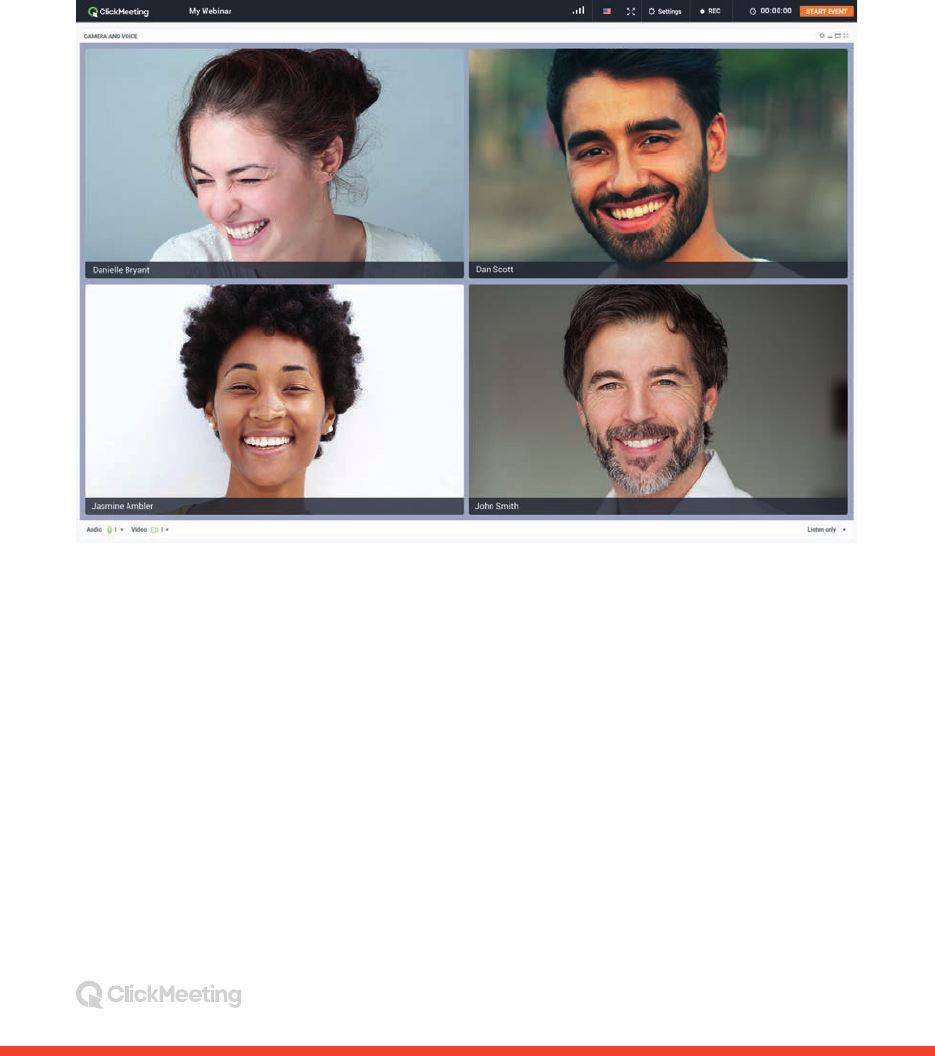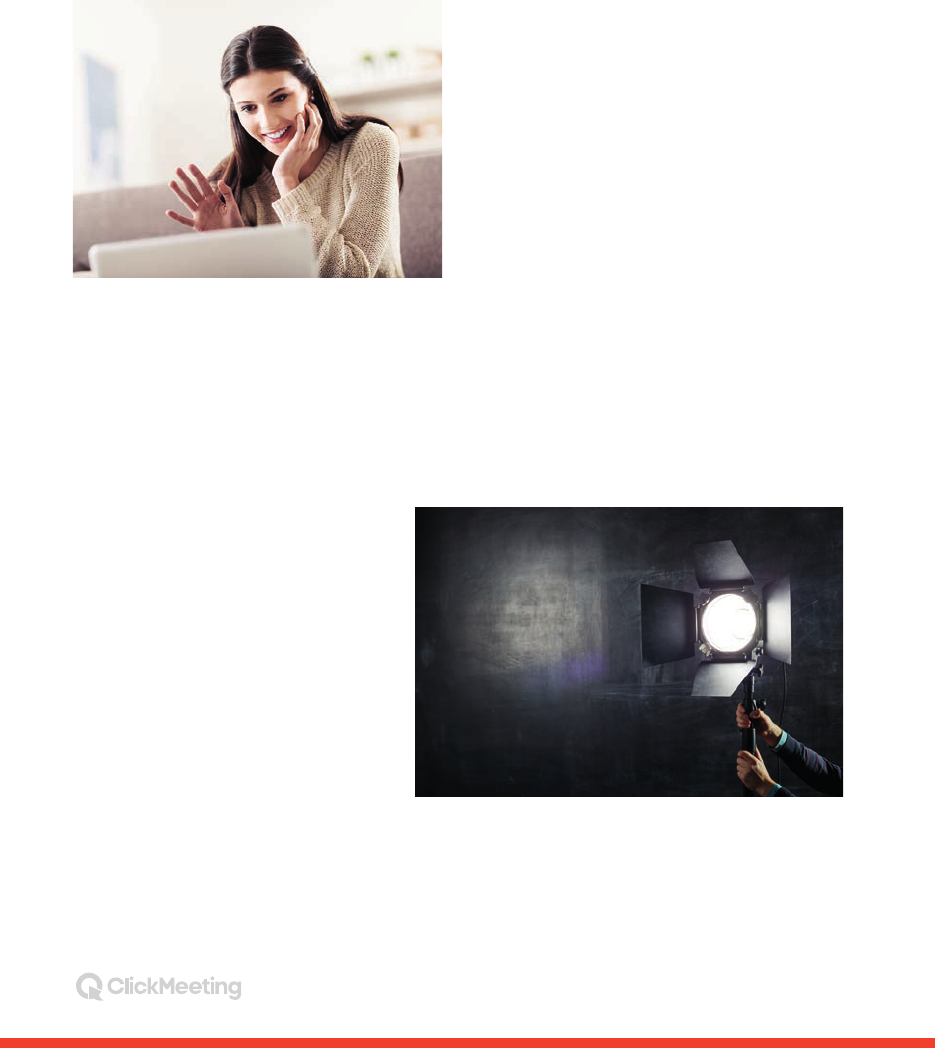

2
Contents
Introduction
Webcam
Lighting
Microphone
Background Noise and Clutter
Internet Connection
Testing
Image and Sound Checklist
Conclusion
3
4
4
5
6
6
7
8
9

Introduction
3
Professionals in all industries - from IT to healthcare to marketing - are embracing webinar technology
as a central means of reaching bigger audiences. The ubiquity and accessibility of webinars can save
time and money across the spectrum of business processes.
But when you incorporate webinars into your communication strategy, pay attention to certain crucial
technical aspects. Ignoring them can spoil your webinar experience. In this short guide, we explain five
elements that make your webinars look professional.

Webcam
One of the main points of having a webinar is to be seen by the audience. A high-quality picture gives your
presentation more eye appeal and projects a professional image. Of course, each webinar platform
has certain limitations on image quality. But you can take steps to make things look good.
4
Lighting
Proper face lighting is the key to making
a good impression. If too dark, you’ll look
menacing; too bright, and you’ll look
goofy.
An on-screen appearance that’s too dark
or too light usually happens in one
of the two situations. One: there aren’t
enough light sources pointed at your face,
which makes your webcam’s sensitivity
auto-adjustment goup, increasing
Place your webcam at eye level on the same screen
you use to view the webinar. Don’t put the camera
angle too high or too low; you want to look directly
at it. If you’re running your webinar on a laptop using
the built-in webcam, place your device on a laptop
stand or box at eye level.
Consider investing in a moderately priced,
high-quality webcam that will present you clearly to
your audience. And of course, make sure it’s turned
on and connected to your webinar software.
If you’re running big events and want to stream them in impressive quality using a professional
stand-alone camera, you also need to buy an on-demand feature: live streaming. So make sure your
webinar provider offers this option.
the visual noise to outrageous levels. Two: a light source - natural through a window or artificial
from a lamp - in the webcam frame. This makes your webcam’s sensitivity auto-adjustment go down,
making your face dark and colorless.

To avoid this, keep windows and other light sources outside your webcam frame. Second, rather than
relying on outside natural light or overhead lights, use several desk lamps. You’ll get the best results
by closing the blinds and pointing two lamps at you from behind your webcam. Place one lamp slightly
to the left and the other slightly to the right. Your face will be clearly visible and in the right colors, making
it more pleasant to watch.
Remember that your face will also be lit by the laptop or monitor, so make sure the main light sources
is stronger than your monitor light. White lighting is usually better than yellow, unless you want to create
a special mood.
5
Microphone
A clear picture is only a half of success. The other half is the sound quality. Poor sound settings can ruin
even the best webinar presentation.
Before you start your webinar, make sure your microphone picks up the right amount of sound.
If it picks up too much, it may cause squeaks, echo, and distortions. If it doesn’t pick up enough,
your audience won’t hear you. Configure your audio settings in advance on your laptop (or another device)
and the webinar room. Check that the microphone you want to use is selected in the audio setting of your
webinar software. And make sure it’s turned on.
Consider investing in an external microphone to improve the quality of sound you broadcast. If the
microphone is on a tripod, place the tripod on a soft surface, such as a piece of sponge foam, to suppress
vibrations the microphone might pick up. Cover the microphone with a sponge cover to avoid a rumbling
sound.
Keep the distance between your mouth and the microphone consistent throughout your event. If you get
feedback, make sure your mic andspeakers aren’t too close together. If you still can’t get rid of the
feedback, use headphones instead of speakers.

Background Noise and Clutter
To keep your audience’s attention, look for possible distractions in your presentation environment.
Excess noise is an obvious one. Conduct your webinar in a quiet space and inform others of your
presence, so no one will interrupt.
Close windows and doors and turn off air conditioners to avoid distracting sounds picked up by your
microphone. In a home office, take the dog outside, put the baby to bed, and finish your laundry before
your live webinar. Silence your devices, including applications you may be running on the device you use
for your event.
Attendees will see everything behind you.
So before you start your event, remove
anything you wouldn’t want others to see.
A clean background helps you appear
competent, organized, and put-together.
Horizontal and repeating patterns don’t
register well on-screen and could create
the illusion of movement and distract your
audience. Go for a bright, solid background
to keep their attention on you.
The same applies to your desktop. If you plan to share your desktop during your webinar, make sure it’s
clear of unnecessary icons and open windows that are unrelated to your discussion. A messy desktop
looks bad and is distracting.
Internet Connection
Connectivity problems are among the most frustrating technical
problems experienced by webinar hosts. Too many users
on a network or poor-quality Internet at remote locations can cause
problems ranging from disconnection to time delay between
picture and words.
Check with your webinar provider to and out the required
bandwidth for an audio/video event including screen sharing
(if planned) and make sure your network meets those
requirements. To measure your bandwidth, visit testmyspeed.com.
6

At the time of your webinar, make sure you have a strong Internet connection and that there are no
broadband-consuming activities in progress on your device, such as video streaming or file downloads.
Bear in mind that an Ethernet cable connection is more reliable than Wi-Fi. To be safe, plug yourself in.
Testing
To reduce the chance of technology failure halfway through your webinar, test everything in advance.
Use the same equipment, from laptop to cables, that you plan to use for the real thing.
Equally important, go through the features of your software and webinar room and make sure you know
how to use them.
You absolutely must practice the entire
presentation all the way through. The best
way to find out what you’ll look like on
camera - and what your presentation will
sound like - is to watch it for yourself.
Make a recording of you giving your
presentation. Then play it back and take
notes on what to improve. Recording your
webinars and actively watching them to
see your mistakes and strengths can help
you improve your art until it’s effortless.
7

Image and Sound Checklist
To remember all the elements described above, go through this checklist before you start your webinar:
Webcam:
Placed at eye level
Turned on and connected
Lighting:
No light sources within webcam frame
Adequate front lighting behind webcam
Microphone:
Volume adjusted
Audio settings configured in device and webinar software
Background:
Quiet environment
Devices silenced, non-essential software disabled
Clean, solid-color background
Clear desktop
Internet connection:
Required bandwidth
Non-essential broadband-consuming software disabled
Dry run:
Equipment and webinar software features tested
Mock presentation done
8

Conclusion
If you’re new to webinars, know that the results depend on small things. So don’t ignore them. Go through
the above list before your event and make necessary arrangements.
If this is your first webinar and you don’t feel quite comfortable with technology, ask an IT-savvy
colleague for help with your initial setup. Alternatively, ask for training from your webinar software
provider. It’s well worth your time. Looking and sounding great help turn your webinar into a success.
9

About
ClickMeeting was founded in 2011 by GetResponse, the leading email marketing platform. The idea was
to provide a complete webinar solution for businesses, large and small. Over the next five years,
ClickMeeting grew so much that, in 2016, it spun off as a separate company.
Our mission is to be the premier provider of flexible, self-service webinar solutions that help you reach,
engage, educate, and convert your audience. ClickMeeting is rich in features that help you before, during,
and after your webinar.
